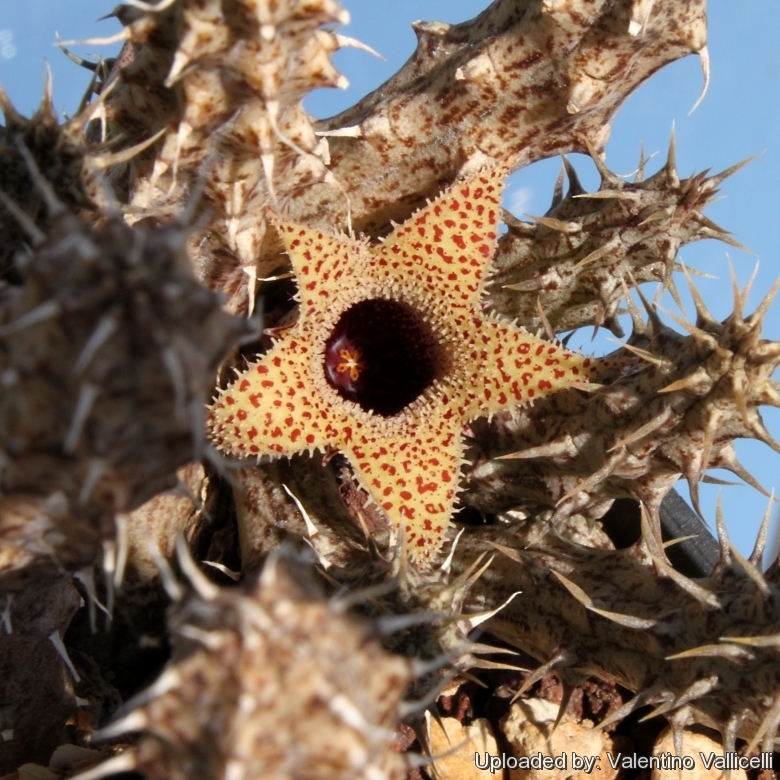
Stapelianthus decaryi Photo by: Valentino Vallicelli
Origin and Habitat: Talanaro, South East Malagasy Republic.
Type Locality: Southern Madagascar, near Anosy, gneiss rocks on the eastern shore of the Ranofotsy Lagoon.
Habitat: Stapelianthus decaryiSN|17851]]SN|17851]] grows mostly in the open, usually on gneiss rocks on acidic substrate, sometimes associated with other succulents, such as Rhipsalis bacciferaSN|6426]]SN|6426]] ssp. horrida, Plecranthus sp. and poikilohydric like as: Coleochloa and Xerophyta dasylirioides.
Synonyms:
Common Names include:
CHINESE (中文): 海葵萝藦, 雷卡雷角
Description: Stapelianthus decaryiSN|17851]]SN|17851]] is a low running succulent that can form large compact clumps and produce small cream-coloured flowers with red spots and white spiny papillae.
Stems: Decumbent-erect, deciduous, 3-10 cm long, 5-15 mm in diameter, 5-8-angled, smooth, grey-green spotted with red-brown, tubercles flattened conical down the ridges, suddenly constricted into subulate rudimentary leaves, these 2-4 mm persistent as dry whitish spiny white tip.
Inflorescences: 1 to 4-flowersd, produced from the base on younger shoots.
Flowers: 12-25 mm in diameter. Stalks 5-8 mm long and 2 mm wide. Sepals 4-7 mm, lanceolate, subulate, acute. Corolla to 2,5 cm across with a broad cylindrical tube 1-1,3 cm, outside pale brown spotted with red-brown, inside cream-coloured, lobes broadly triangular, acute, reflexed, about 8 mm, recurved, pallid with with purple flecks upper half with spine-tipped papillae to 1 mm, tip with minute red hairs. Corona purple. Pollinia 0,5 by 0,3 mm, wings of the translator approx. 0,2 mm long, narrow, obtuse. Flowers smell like a dead rotting animal which baked in the sun and are very attractive to the flies that pollinate them. Sometimes flies lay eggs on the flower.
Fruit: Typical twin seed horns (follicles) up to 10 cm long, 8 mm wide, narrowly fusiform, acute and often don't appear until a year later.
Bibliography: Major references and further lectures
1) Werner Rauh, Herman Schwartz “Succulent and xerophytic plants of Madagascar” Volume 2 Strawberry Press, 1998
2) White & Sloane. “The Stapelieae” edn 2. Abbey San Encino Press, 1937
3) James Cullen, Sabina G. Knees, H. Suzanne Cubey “The European Garden Flora Flowering Plants: A Manual for the Identification of Plants Cultivated in Europe, Both Out-of-Doors and Under Glass” Cambridge University Press, 11/Aug/2011
4) Hermann Jacobsen “A handbook of succulent plants: descriptions, synonyms, and cultural details for succulents other than Cactaceae", Volume 1 Blandford Press, 1960
5) Bruyns, P.V. "Stapeliads of Southern Africa and Madagascar" Volume I Umdaus Press, Hatfield, South Africa Pages 257 - 259 2005
6) Focke Albers, Ulrich Meve “Illustrated Handbook of Succulent Plants: Asclepiadaceae” Volume 5 Springer, 2002
7) Sajeva, Maurizio and Costanzo, Mariangela. "Succulents: The Illustrated Dictionary" Portland, Ore.: Timber Press, 1994.
8) James Cullen, Sabina G. Knees, H. Suzanne Cubey “The European Garden Flora Flowering Plants: A Manual for the Identification of Plants Cultivated in Europe, Both Out-of-Doors and Under Glass” Cambridge University Press, 11/Aug./2011
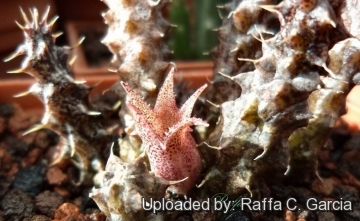 Stapelianthus decaryi Photo by: Raffa C. Garcia
Stapelianthus decaryi Photo by: Raffa C. Garcia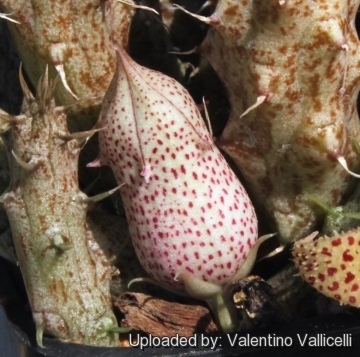 Stapelianthus decaryi Photo by: Valentino Vallicelli
Stapelianthus decaryi Photo by: Valentino Vallicelli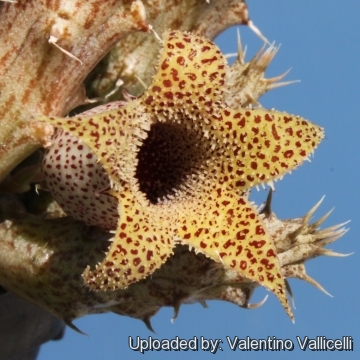 Stapelianthus decaryi Photo by: Valentino Vallicelli
Stapelianthus decaryi Photo by: Valentino Vallicelli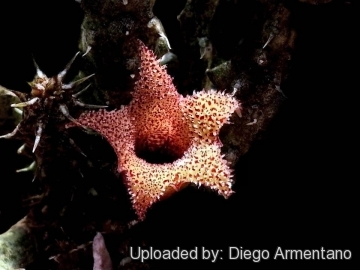 Stapelianthus decaryi Photo by: Diego Armentano
Stapelianthus decaryi Photo by: Diego Armentano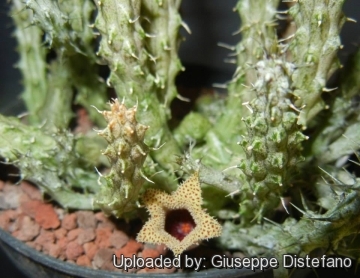 Stapelianthus decaryi Photo by: Giuseppe Distefano
Stapelianthus decaryi Photo by: Giuseppe Distefano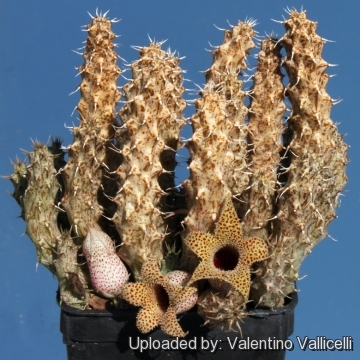 Stapelianthus decaryi Photo by: Valentino Vallicelli
Stapelianthus decaryi Photo by: Valentino Vallicelli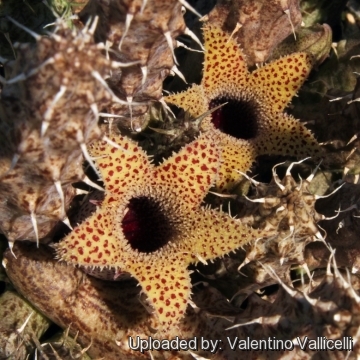 Stapelianthus decaryi Photo by: Valentino Vallicelli
Stapelianthus decaryi Photo by: Valentino Vallicelli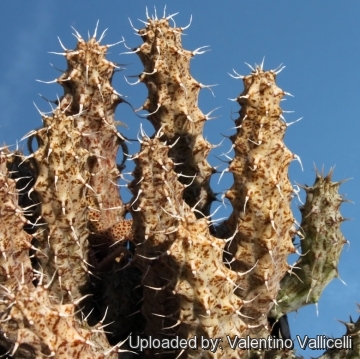 Stapelianthus decaryi Photo by: Valentino Vallicelli
Stapelianthus decaryi Photo by: Valentino VallicelliCultivation and Propagation: Stapelianthus decaryiSN|17851]]SN|17851]] is a xerophytic plant adapted to dry soils, but despite its provenance it is without doubt an easy species to grow and not difficult as commonly supposed only bearing in mind that this species benefits from slightly warmer winter than others.
Growth rate: It is a relatively rapidly growing and easily flowering species that will make large clumps given the best conditions. Most plants will offset readily, and clumps can be produced in a few years.
Soils: It likes very porous mineral cactus mix soil, pH 7,5 to 8,5 (mildly alkaline), but can become too elongated if compost is too rich.
Repotting: This plant needs plenty of space for its roots, repotting should be done every other year or when the it has outgrown its pot. Use pot with good drainage.
Watering: It needs regular watering, especially during the hottest summer days; provide also some light watering if the green house temperatures in winter are elevated. Either excessive or very scarce watering can induce rot.
Fertilization: Feed with a high potassium fertilizer in summer.
Frost Tolerance: For safe cultivation it is best to avoid freezing temperatures (minimum 5° C). In the rest period no high atmospheric humidity!!
Sun Exposure: Best for half-shade but grow well in full sun and full shade too. Tends to bronze in strong light, which encourages flowering, but is likely to suffer from sun scorch or stunted growth if over exposed to direct sunlight during the hottest part of the day in summer.
Diseases: This species is relatively resistant to cryptogamic diseases than others and is quite resistant to the “Balck spot” disease of Asclepiads. Rot it is only a minor problem with Stapelianthus decaryiSN|17851]]SN|17851]] if the plants are watered and “aired” correctly. If they are not, fungicides won't help all that much.
Uses: It is an excellent plant for container growing. Cascading, clustering, great for a hanging display. Stems may possibly become purple and limp in winter, but revitalize in early spring. It always looks good and stays small. It look fine in a cold greenhouse and frame or outdoor in a rockery.
Propagation: Seeds and cuttings. Cuttings will root only in hot weather. Cuttings must be kept very dry to root. Seeds germinate readily if they are sown when fresh.



















